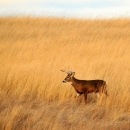Seasons of Wildlife
The world of nature is one of continuous change. Winter gives way to the warm breezes of spring. Eagles hatch, and in a few short months young eagles test their wings over the saltmarsh. Leaves turn from green to gold and softly drop to the forest floor as migrating waterfowl once again wing south ahead of the first snows of winter. This calendar, highlighting many of the changes the natural community goes through at Bombay Hook, has been prepared to help you plan future visits to the refuge.
January
Red tailed, marsh and rough-legged hawks are commonly observed.
Bald eagles begin working on their nests.
Whitetail deer herds are seen in the fields at dusk.
February
Bald eagle eggs are laid and incubation begins.
Large flocks of Pintail ducks arrive with the first mild weather of the month.
March
The spring waterfowl migration peaks Ducks, snow geese and Canada geese are abundant.
Woodchucks and turtles emerge from hibernation.
Woodcock courtship flights occur.
Alders and red Maples flower.
Deer ticks emerge.
April
Bald eagle eggs hatch.
Early spring songbird migration begins.
Purple Martins return.
Spring peeper chorus and wood frog chorus is in full voice.
Spring wildflowers in bloom.
May
Peak concentrations of shorebirds.
Horseshoe crabs move onto the bay shore and begin laying eggs.
Bullfrogs and green frogs join in the swamp chorus.
Warbler migration peaks. Snapping turtles lay eggs.
Tulip trees and spring wildflowers are in full bloom.
Duck broods appear.
First whitetail deer fawns are seen.
June
Diamond back terrapins lay eggs on dikes.
Baby eagles leave the nest.
Water lilies bloom.
Black necked stilts begin nesting in impoundments.
July
Many duck broods are present in Bear Swamp Pool.
The first shorebirds arrive late in the month on their southward migration flight.
Large concentrations of wading birds, including herons, egrets and ibis are present.
Whitetail deer bucks with antlers in velvet.
August
Increased numbers of shorebirds.
Green-winged and blue-winged teal begin to arrive.
Cardinal flowers, rose mallow and meadow beauties are in bloom.
September
Late migrating shorebirds and songbirds are present.
Duck numbers increase.
First Canada geese arrive.
Tickseed sunflower, goldenrod and Joe-Pye-weed in flower.
October
Best month for Avocets.
Large numbers of Canada and Snow geese arrive.
Duck numbers increase as pintail, mallard and black ducks begin their fall migration.
Bur marigolds bloom in freshwater pools.
November
Peak of fall waterfowl migration. Common species include Canada geese, snow geese, (blue and white phases), gadwall, mallard, black duck, pintail, American widgeon, wood duck, northern shoveler, blue-winged and green-winged teal, scaup, bufflehead, ruddy duck, red-breasted and hooded merganser.
December
Eagles often seen perched on leafless branches.
High populations of wintering birds, especially waterfowl, throughout the month unless a hard freeze pushes them further south.
Conclusion
Because of the abundance of wetland habitat on the refuge, mosquitoes, and biting fly populations are very high from June through September. During these months, the refuge staff suggests you wear long sleeves and slacks, and bring insect repellant and a headnet when you visit.
Featured Species
Here are some of the amazing fauna that make up the natural community of Bombay Hook NWR.


